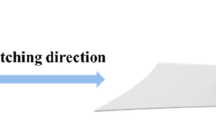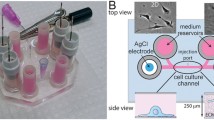Abstract
Recent studies have highlighted the strong influence of microenvironmental stiffness on various cell fates including proliferation, migration, and differentiation in both two- and three-dimensional culture conditions. Our study attempts to understand the role of 3D microenvironmental stiffness on cell cytotoxic response using neural glioblastoma U-87 cells encapsulated in alginate hydrogel matrices of varying stiffness as the model system. Interestingly, we observed that cells encapsulated in soft alginate matrices were more sensitive to the toxic chemicals relative to cells encapsulated in stiffer matrices. The observed dependence of toxic responses on matrix stiffness was also seen for other neural cell lines including U-251 glioblastoma and IMR-32 neuroblastoma cells. Given the established involvement of Rho GTPases in mediating mechanosensitive cell responses, we also performed the toxicity assays using U-87 cells expressing constitutively active mutants of the Rho GTPase RhoA. Under these conditions, the toxic responses were similar for U-87 cells cultured in both soft and stiff matrices. These results suggest a strong role of mechanotransductive signaling on the response of neural cells to toxins. We believe that determining the role of substrate stiffness on the toxic response of neural cells will be crucial to the development of optimal in vitro cell-based screens of neurotoxicity.




Similar content being viewed by others
References
Bal-Price, A. K., H. T. Hogberg, L. Buzanska, and S. Coecke. Relevance of in vitro neurotoxicity testing for regulatory requirements: challenges to be considered. Neurotoxicol. Teratol. 32:36–41, 2010.
Banerjee, A., M. Arha, S. Choudhary, R. S. Ashton, S. R. Bhatia, D. V. Schaffer, and R. S. Kane. The influence of hydrogel modulus on the proliferation and differentiation of encapsulated neural stem cells. Biomaterials 30:4695–4699, 2009.
Bensamoun, S. F., L. Robert, G. E. Leclerc, L. Debernard, and F. Charleux. Stiffness imaging of the kidney and adjacent abdominal tissues measured simultaneously using magnetic resonance elastography. Clin. Imaging 35:284–287, 2011.
Chen, J., J. Irianto, S. Inamdar, P. Pravincumar, D. A. Lee, D. L. Bader, and M. M. Knight. Cell mechanics, structure, and function are regulated by the stiffness of the three-dimensional microenvironment. Biophys. J. 103:1188–1197, 2012.
Discher, D. E., P. Janmey, and Y. L. Wang. Tissue cells feel and respond to the stiffness of their substrate. Science 310:1139–1143, 2005.
Elkin, B. S., E. U. Azeloglu, K. D. Costa, and B. Morrison, III. Mechanical heterogeneity of the rat hippocampus measured by atomic force microscope indentation. J. Neurotrauma 24:812–822, 2007.
Frampton, J. P., M. R. Hynd, M. L. Shuler, and W. Shain. Fabrication and optimization of alginate hydrogel constructs for use in 3D neural cell culture. Biomed. Mater. 6:015002, 2011.
Grandjean, P., and P. J. Landrigan. Developmental neurotoxicity of industrial chemicals. Lancet 368:2167–2178, 2006.
Hall, A. Rho GTPases and the actin cytoskeleton. Science 279:509–514, 1998.
Her, G. J., H. C. Wu, M. H. Chen, M. Y. Chen, S. C. Chang, and T. W. Wang. Control of three-dimensional substrate stiffness to manipulate mesenchymal stem cell fate toward neuronal or glial lineages. Acta Biomater. 9:5170–5180, 2013.
Huang, H., R. D. Kamm, and R. T. Lee. Cell mechanics and mechanotransduction: pathways, probes, and physiology. Am. J. Physiol. Cell Physiol. 287:C1–C11, 2004.
Keung, A. J., E. M. de Juan-Pardo, D. V. Schaffer, and S. Kumar. Rho GTPases mediate the mechanosensitive lineage commitment of neural stem cells. Stem Cells 29:1886–1897, 2011.
Keung, A. J., K. E. Healy, S. Kumar, and D. V. Schaffer. Biophysics and dynamics of natural and engineered stem cell microenvironments. Wiley Interdiscip. Rev. Syst. Biol. Med. 2:49–64, 2010.
Kuo, C. K., and P. X. Ma. Ionically crosslinked alginate hydrogels as scaffolds for tissue engineering: Part 1. Structure, gelation rate and mechanical properties. Biomaterials 22:511–521, 2001.
Lampe, K. J., R. G. Mooney, K. B. Bjugstad, and M. J. Mahoney. Effect of macromer weight percent on neural cell growth in 2D and 3D nondegradable PEG hydrogel culture. J. Biomed. Mater. Res. A 94:1162–1171, 2010.
Lan, S. F., and B. Starly. Alginate based 3D hydrogels as an in vitro co-culture model platform for the toxicity screening of new chemical entities. Toxicol. Appl. Pharmacol. 256:62–72, 2011.
Lee, M. Y., R. A. Kumar, S. M. Sukumaran, M. G. Hogg, D. S. Clark, and J. S. Dordick. Three-dimensional cellular microarray for high-throughput toxicology assays. Proc. Natl Acad. Sci. U.S.A. 105:59–63, 2008.
Lessey, E. C., C. Guilluy, and K. Burridge. From mechanical force to RhoA activation. Biochemistry 51:7420–7432, 2012.
Lim, S. M., J. P. Trzeciakowski, H. Sreenivasappa, L. J. Dangott, and A. Trache. RhoA-induced cytoskeletal tension controls adaptive cellular remodeling to mechanical signaling. Integr. Biol. (Camb) 4:615–627, 2012.
MacKay, J. L., A. J. Keung, and S. Kumar. A genetic strategy for the dynamic and graded control of cell mechanics, motility, and matrix remodeling. Biophys. J. 102:434–442, 2012.
McBeath, R., D. M. Pirone, C. M. Nelson, K. Bhadriraju, and C. S. Chen. Cell shape, cytoskeletal tension, and RhoA regulate stem cell lineage commitment. Dev. Cell 6:483–495, 2004.
Paterson, H. F., A. J. Self, M. D. Garrett, I. Just, K. Aktories, and A. Hall. Microinjection of recombinant p21rho induces rapid changes in cell morphology. J. Cell Biol. 111:1001–1007, 1990.
Pathak, A., and S. Kumar. Independent regulation of tumor cell migration by matrix stiffness and confinement. Proc. Natl Acad. Sci. U.S.A. 109:10334–10339, 2012.
Peyton, S. R., P. D. Kim, C. M. Ghajar, D. Seliktar, and A. J. Putnam. The effects of matrix stiffness and RhoA on the phenotypic plasticity of smooth muscle cells in a 3-d biosynthetic hydrogel system. Biomaterials 29:2597–2607, 2008.
Wang, N., J. D. Tytell, and D. E. Ingber. Mechanotransduction at a distance: mechanically coupling the extracellular matrix with the nucleus. Nat. Rev. Mol. Cell Biol. 10:75–82, 2009.
Weiss, B. Lead, manganese, and methylmercury as risk factors for neurobehavioral impairment in advanced age. Int. J. Alzheimers Dis. 2011 607543, 2010.
Acknowledgments
We thank Sanjay Kumar at University of California, Berkeley for the CA RhoA U-87 and DN RhoA U-87 cells and Joanna L. MacKay for help with the culture of the cells. We would like to thank those Bioengineering undergraduate students from the Fall 2012 Tissue Engineering class at Santa Clara University for assistance in data collection. We thank Jose Marcial Portilla for assistance in preparing the figures, Sabrina A. Cismas and Nicolo Philip Mendoza for critical reading of the manuscript and helpful suggestions. This research was supported by School of Engineering, Santa Clara University.
Conflicts of interest
Kalpith Ramamoorthi, Jared Hara, CadeEllis Ito, and Prashanth Asuri declare that they have no conflicts of interest.
Ethical standards
No human studies were carried out by the authors for this article. No animal studies were carried out by the authors for this article.
Author information
Authors and Affiliations
Corresponding author
Additional information
Associate Editor Michael R. King oversaw the review of this article.
Jared Hara and CadeEllis Ito: These authors contributed equally to this work.
Electronic supplementary material
Below is the link to the electronic supplementary material.
Rights and permissions
About this article
Cite this article
Ramamoorthi, K., Hara, J., Ito, C. et al. Role of Three-Dimensional Matrix Stiffness in Regulating the Response of Human Neural Cells to Toxins. Cel. Mol. Bioeng. 7, 278–284 (2014). https://doi.org/10.1007/s12195-014-0326-y
Received:
Accepted:
Published:
Issue Date:
DOI: https://doi.org/10.1007/s12195-014-0326-y




